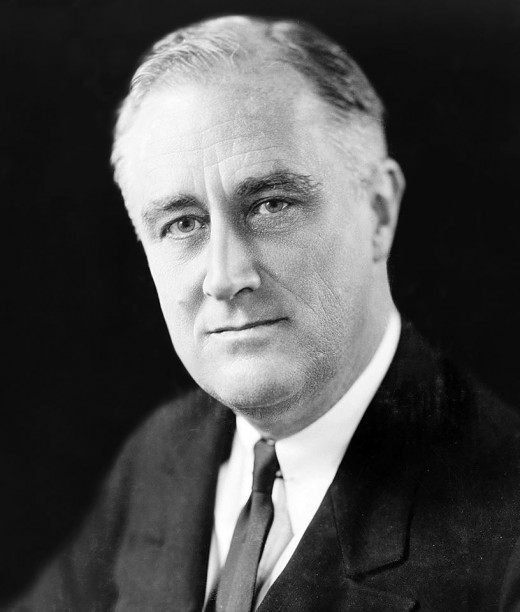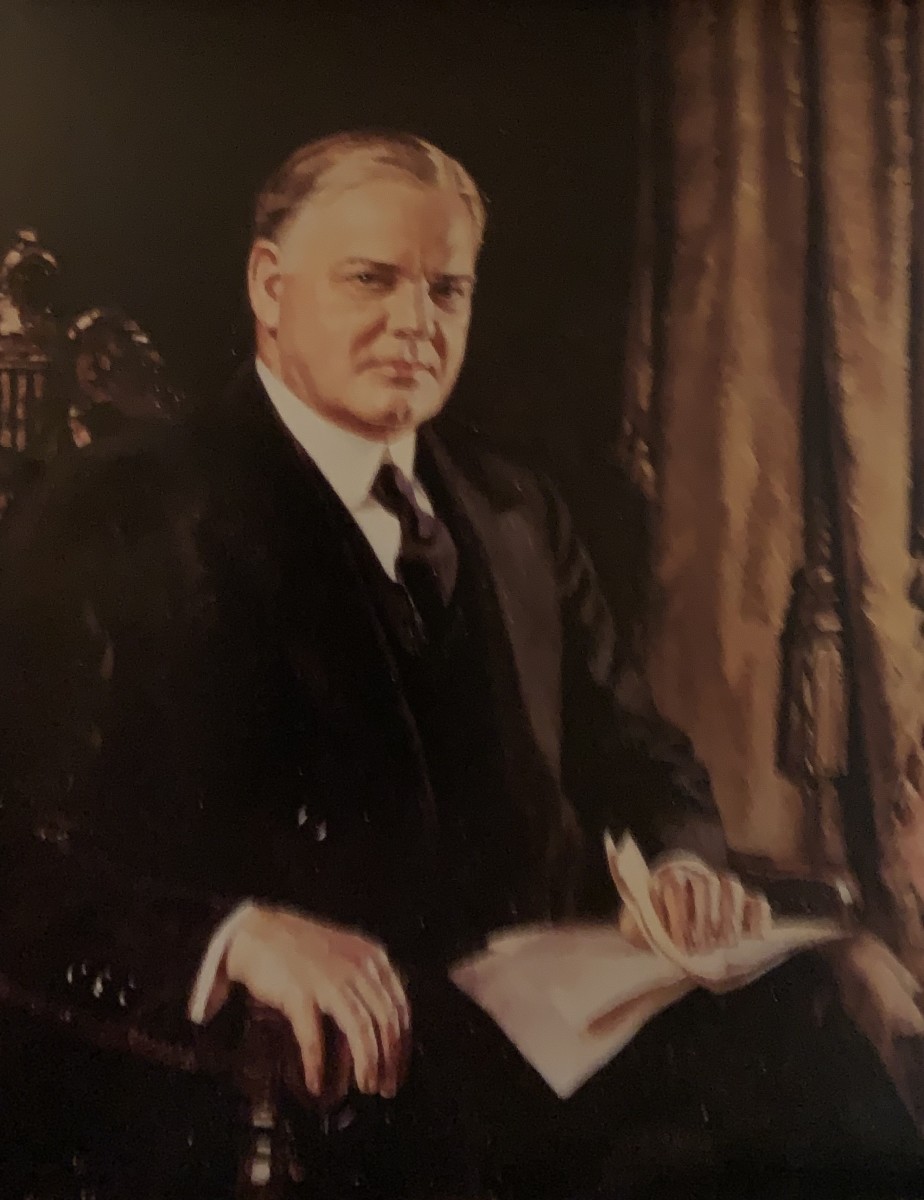Franklin d. Roosevelt - 32nd U.S. President

Franklin Roosevelt was born on January 30, 1882 into one of the oldest Dutch families in New York. Both his parents were from wealthy families and descended from English and Dutch immigrants. One ancestor served in the militia in the American Revolution thus inspiring Franklin to join the Society of Sons of the American Revolution when he became president. Much of his family’s wealth came from his maternal grandfather Warren Delano Jr. trading opium and tea with China.
Growing up in a home of privilege allowed Franklin to make frequent trips to Europe with his mother. By the age of 15 he had made the trip 16 times which helped him become fluent in German and French. He was also skilled in golf, sailing, shooting, rowing, polo and lawn tennis.
While attending Groton School, an Episcopal boarding school in Massachusetts, he was influenced by his headmaster, Mr. Peabody, who urged his students to help the less fortunate and work in public service. They remained friends for over forty years. Mr. Peabody officiated at Franklins wedding and was a frequent visitor when he became president.
An average student, Franklin attended Harvard College and was a member of the Alpha Delta Phi fraternity and the Fly Club. He also became the editor-in-chief of The Harvard Crimson daily newspaper. While at Harvard, republican Theodore Roosevelt Jr. Franklin’s fifth cousin, was elected President of the United States. Although Franklin admired his cousin’s leadership, he remained an active democrat campaigning for Theodore’s opponent.
During school while on a train ride with his niece, Franklin met his future wife, Eleanor – a fifth cousin once removed. He graduated from Harvard in 1903 with an A.B degree in history. In 1929 he received an honorary LL.D from Harvard. He entered Columbia Law School in 1904and dropped out in 1907 after passing the New York Bar exam.
Franklin and Eleanor married on March 17, 1905 with President at her side standing in for her deceased father. She was after all his favorite niece. Sara, Franklin’s mother thought he was too young to get married and tried several times to break them up. Moving to the family’s estate in Springfield Eleanor, shy and disliking social life, at first stayed at home and raised their children. They had six children, one of which, the third child, died of heart disease in infancy.
Roosevelt had several affairs during his marriage to Eleanor. One which began with Eleanor’s social secretary Lucy Mercer. Franklin wanted a divorce but Lucy would not marry a divorced man with 5 children. Although he agreed to not see Lucy again they continued correspondence and did start seeing each other again in 1941. Lucy was with him when he died. He also had an affair with his private secretary and a suspected affair with Princess Martha of Sweden.
After these affairs, Eleanor wrote to a friend that she would never forget what had happened and soon moved into a separate house in Hyde Park. There she delved into social and political causes. The remaining time of their marriage was more for a political ‘front’ than an intimate relationship.
While vacationing in Campobello Island in Canada in August 1921, Franklin contracted polio. He decided to stay out of the public for many years while staying at home reading and stamp collecting. Although the polio left him paralyzed from the waist down, he did all he could to improve his condition. He believed it was important to have the public believe he was improving. He tried hydrotherapy and founded the National Foundation for Infantile Paralysis, now known as the March of Dimes. He had special iron braces fitted for his hips and legs and tried not to be seen in public in his wheelchair. It was important to him to be seen in public standing upright with the support of the braces, a cane and support of an aide.
In 1910 Roosevelt ran for New York state senate on the Democrat ticket which he won on a landslide election. He was reelected in 1912 and served as chairperson of the agricultural committee while passing farm and labor bills and social welfare programs. Having supported Woodrow Wilson in the 1912 Democratic Convention, he was appointed Assistant Secretary of the Navy where he founded the U.S. Naval Reserve.
In 1914 he decided to run for U.S. Senate seat for New York where he lost due mostly to lack of support and many political enemies in the New York democrats. Despite this loss his political career was thriving. In 1920 he accepted the nomination for vice-president with James M. Cox. Once again he was defeated. In 1928 he ran for governor of New York and was elected by a narrow one-percent margin. In 1930 he ran for a second term at which time the Great Depression was being blamed on the Republican Party, and he was elected by a margin of just fourteen percent.
November 1932, Franklin defeated Herbert Hoover for president. He believed the government should intervene in the economy to help provide relief and recovery. He won with a 57 percent of the vote. In his first 100 days in office he crafted the “New Deal” which called for economic reform. He ordered temporary closure of banks and formed the ‘Brain Trust’, a group of economic advisors and the Civilian Conservation Corps which would employ 250,000 young men to work on rural projects. He created the National Recovery Administration which regulated wages and prices. All along, he kept in charge and control of his administration.
Before his second landslide election in 19 37 he had repelled Prohibition, cut the federal budget, imposed new banking regulations and the Security and Exchange Commission to regulate Wall Street and cut the federal budget. Unemployment fell from 25% to 14%. His second term saw more opposition to his new programs. Some saw him as trying to be more of a dictator than a president.
Franklin’s foreign policy during the Nazi aggression was to try to stay neutral. He gave a Quarantine Speech declaring that warmongering countries be quarantined even though he was secretly having long-range submarines built to blockade Japan. He formed a close relationship with Winston Churchill discussing ways to help Britain yet still not be in the war. By 1941 his advisors recommended that the U.S spend $50 billion Britain, China and the Soviet Union for military supplies. In an unprecedented bid for a third-term, Franklin stressed his ability of leadership and to do everything possible to keep the U.S. out of war. He won by 55% of the popular vote.
Domestic problems were not a priority at this time. The military build-up added to the economic growth. After the American ship was fired on by the Germans, Franklin ordered the Navy to be escorts for the allies. Senior military officials felt war was imminent and an attack by Japan was ‘probable”.
“Yesterday, December7, 1941 – a date which will live in infamy- the United States of America was suddenly and deliberately attacked by naval and air forces of the Empire of Japan”. Roosevelt called for war after an attack on Pearl Harbor that killed over 2,400 Americans. Soon after the Germans and Italians declared war on the United States. On January 1942 Winston Churchill and Roosevelt issued the ‘Declaration by United Nations” representing 26 nations in opposition of Germany, Italy and Japan.
Fear of Japan invading the U.S. caused President Roosevelt to sign an order to move all Japanese descendants away from the Pacific Coast. This led to a relocation of thousands of Japanese immigrants and their children to interior ‘camps’. They were forced to give up their homes and businesses. A move that is still today, upsetting to Japanese/Americans.
Dwight D. Eisenhower was chosen by Franklin to lead the allied invasion in Europe. By 1943-1944 major bombing over Germany was causing huge amounts of damage and cutting off all supplies. Operation Overload also known as D-Day, started on June 6, 1944, the plan by Roosevelt and Churchill to bring an end to the war in Europe. Although the war with Japan was ongoing and thought to be making progress to defeat the Japanese, Franklin insisted the bigger war effort be made against Germany.
Re-election in 1944 for a fourth term was never before done. Franklin was declining in health and the war was still ongoing. Harry S. Truman was his new running mate who was against corruption and the over spending during war-time. On March 1945 Franklin spent time to rest at the Little White House at Warm Springs. He died on April 12, 1945 of a massive cerebral hemorrhage.





